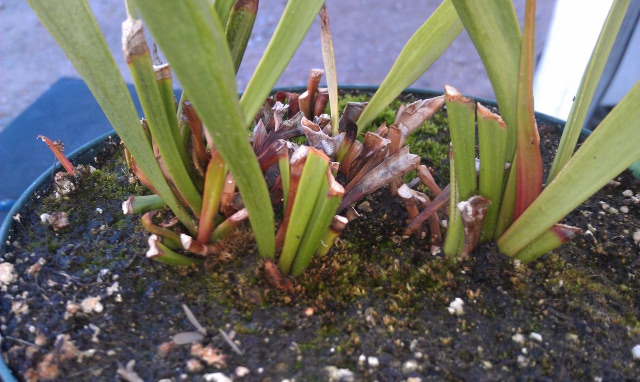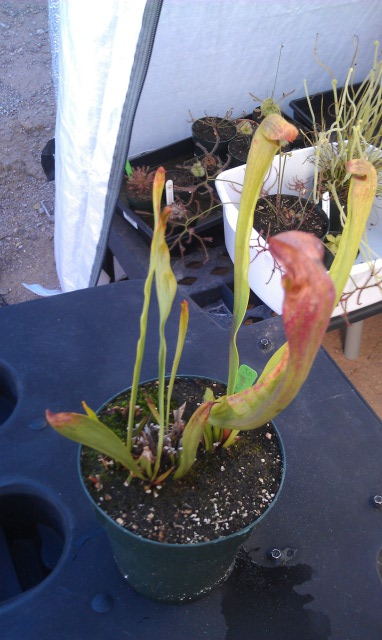Question Minor Hybrid Rhzome
Minor Hybrid Rhzome
 Minor Hybrid
Minor Hybrid
QUESTION: Here are some pictures.
ANSWER: Hi Jason,
Thanks for the photos. That helps. This looks like a problem we're having this year too which is Thrips. They are very hard to see. On our plants I saw what looked like aphid damage on a group of S. alata, but I didn't see the tell-tale white casings from the shed exoskelotons. I sprayed with a Bayer imidacloprid product, but the damage didn't stop, and started to show up on other plants. I finally took one last week and examined it very carefully with a hand lens and saw little pale, long bodied critters on damaged new foliage. These were larval thrips. We're fighting them on Nepenthes too.
The bad news is that imidacloprid doesn't work on them; they seem to be immune to it. The good news is that you can kill them with Orthene (Acephate). You should be able to find this in Arizona as a powder to kill fire ants. Here's an example: http://www.amazon.com/Fire-Ant-Killer-with-Acephate/dp/B003I6YWHK/ref=sr_1_11?ie That powder is 75%, and you mix 1/2 teaspoon to a gallon of water. Spray the crown of the plant, and allow some to soak into the soil. It's an organophosphate systemic insecticide that stays in the plant for around 30 days. It kills by poisoning the bugs when they eat it as opposed to contact. I've used Orthene in the past, and it's pretty safe on most cp. I would spray in the evening when it's cooler. Be sure to follow the safety directions for this is pretty nasty stuff, and it stinks. It's not terribly toxic to vertebrates, but caution is always a good idea.
It would be good to transplant this plant a week or so after the treatment to get rid of any eggs in the soil. When you do that, look at the rhizome to see if any other damage has happened. The Orthene would kill most bug issues, but some root damage would explain your plant's appearance also.
Let me know how it goes.
Good Growing!
Jeff Dallas
Sarracenia Northwest
http://www.growcarnivorousplants.com
---------- FOLLOW-UP ----------
QUESTION: Thank you very much Jeff. I will look into getting that insect killer. I do have the Bayer rose and flower insect killer that is a systemic killer. Is that the one you said they are immune to??
Thanks Again,
Jason
ANSWER: Hi Jason,
Yes. Bayer Rose and Flower has a combination of Cyfluthrin and Imidacloprid. It had no effect on the Thrips, and that was after multiple sprays.
If you get the product I described before, use 1 teaspoon per gallon of water. After further research I realized that the 1/2 tsp. might not be strong enough. Thrips are a pretty tough customer.
Good Growing!
Jeff Dallas
Sarracenia Northwest
http://www.growcarnivorousplants.com
---------- FOLLOW-UP ----------
QUESTION: Jeff, thanks again. I have ordered the stuff you suggest. I'll go one teaspoon per gallon of water, unless your research may suggest a higher dosage. I have found similar growth concerns on my Alata and scarlet bell. My scalet bell was growing very nice than it just stoped and the tops of the pitchers burn. That may be just the climate messing with it we have had good rains this year but its been hot.
Three questions, can I transplant now then treat the plants of concern or treat then transplant?
Second, can I do a preventive treatment on my other Sarracenia and fly traps?
Last will these pests die off this winter?
Thanks for all your help, my growth this season has been very disappointing. I hope this helps them to put out some nice leaves before they shut down.
AnswerHi Jason,
You can transplant first, but spray right away afterwards. You don't want them laying any eggs in the soil.
A preventative spray should be fine. Test one flytrap before spraying all of them. The formula I found was on a flytrap forum, so it should be safe. I've used in on them in the past successfully. In the nursery I haven't found the flytraps to be affected by them. One common indicator that you have Thrips is little black dots in the damaged area. If you see that, then do spray. Definitely spray when it's cooler.
From what I've read some species die off, and some don't. They are hard to identify which ones you might have. In my case I only saw larvae and not adult insects. In addition, your winters are not real cold.
Good Growing!
Jeff Dallas
Sarracenia Northwest
http://www.growcarnivorousplants.com







